Don’t even waste the 19 seconds that this screencast takes, just head over to WhaleSynth – A Unique Musical Experience and make some whale sounds. Via kottke. Lovely in many ways.
WhaleSynth
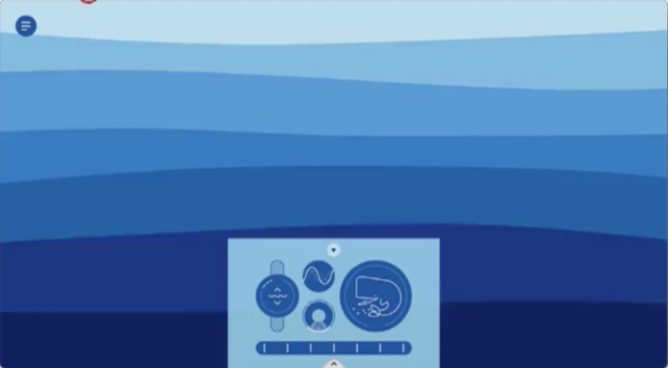


Don’t even waste the 19 seconds that this screencast takes, just head over to WhaleSynth – A Unique Musical Experience and make some whale sounds. Via kottke. Lovely in many ways.

TL:DR I’ve found a link that leads to google image search for images labeled for noncommercial reuse. This is handy on iOS where it is hard to get to the Usage Rights Filter, here is the link: https://www.google.co.uk/search?q=&lr=&safe=active&hl=en-GB&tbs=sur:f&tbm=isch.
Coming back to the classroom after 9 years I find I am still interested in searching for images and copyright. It still seems to be as hard to get young children to understand the problem and harder to understand and carry out attribution.
On my classes blog I link to various places to search for images with some advice on attribution. I include my FlickrCC Stampr tool which can simplify the attribution.
As well as the problem with attribution there is the ever present temptation just to search google. This is made worse by the fact that the Search Tools displayed on iOS lack the Usage Rights popup.
So I was interested in the link I saw today: How to find Google images with reuse licenses on an iPad iOS – Using Technology Better.
Unfortunately this method was described as a hack and took 6 steps to get to the advanced search and the usage rights pop up.
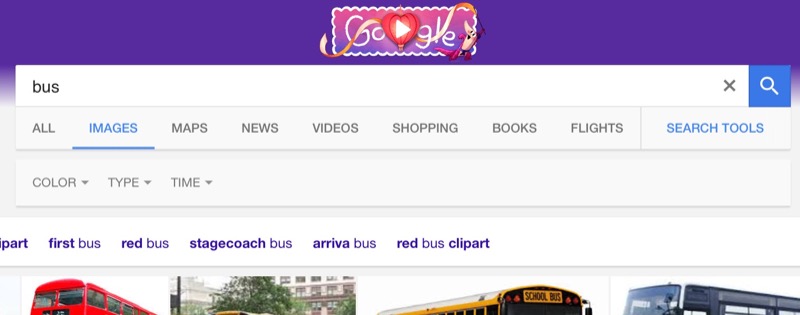

So I though I might have a search for the url parameters1 involved in a search with the Usage rights displayed.
There are quite a lot of parameters and although searching google for a list provides some these seem to be both undocumented and changeable:
You can expect that a lot of this will change. The reason why Google themselves do not provide any guidance or documentation on these parameters is probably that they want to retain full freedom to change how they work. You can expect that some will be removed, some will be added, and others will give a different result than before.
from: Google Search URL Request Parameters | DETECTED Which give a lot of details, but not the one I wanted.
So I went through the process in the Using Technology Better post and copied the url. I then started deleting the parameters until I found the ones that would produce the right kind of search:
https://www.google.co.uk/search?q=&lr=&safe=active&hl=en-GB&tbs=sur:f&tbm=isch
The tbm=isch bit makes it an image search, the tbs=sur:f seems to set the usage rights to Labeled for noncommercial reuse.
So you can now give pupils on iOS a direct link to search for images that labeled for noncommercial reuse.
Featured Image: found searching Flickr for search with no known copyright restrictions: Image from page 211 of “Bulletin” (1961-1962) by Internet Archive Book Images No known copyright restrictions
1. The paramaters are the bits in the url after ? for example ?q=bus&safe=active, makes a search for a bus safe. ↩
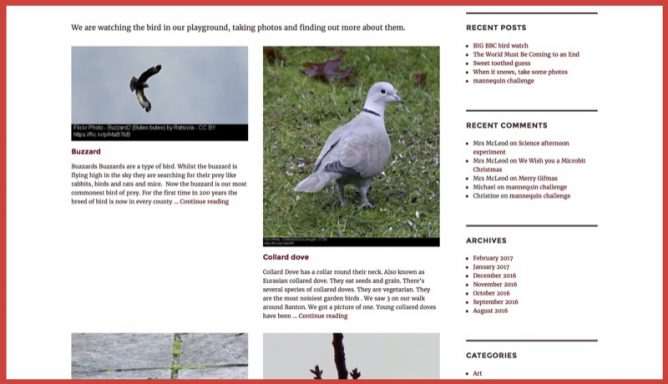
This is hopefully a useful tip for organising pupil created content on WordPress blogs like Glow Blogs.
Most of the content posed to blogs consists of posts or pages. Posts join the stream, pages are static generally accessed from menus.
This is another way to organise content that can be useful. Especially if several pupils are posting similar content at the same time. It helps organise that content and the early posters don’t get pushed away down the stream.
At school we are trying to pay attention to the local birdlife. We took part in the BIG BBC Bird watch with local Bird watchers, Mr & Mrs Carter. We started feeding the birds and trying to get some photos.
The pupils are doing a bit of research on the birds we saw (not too many it was a windy hour) and I hope they will continue over time adding other birds seen in the playground and around.
I want to organise these bits of research automatically collecting them together. To do this the pupils create, not posts or pages but a custom post type, project.
This is just one way to do this but it is, at least on Glow Blogs, the most straightforward. It uses the JetPack Custom Content Types module and the unfortunately 1 named Portfolio Projects.
These projects are like pages in that they are out of the flow but like posts have Project Types (like categories) and Project Tags (like tags) that can be used to organise them. The also have a shortcode that can be used to create an index of the projects by type or tag2.
To create an index of these projects I add a page Banton Birds and add a shortcode to the page:
[portfolio include_type=birds display_types=false]
To make the index more visual the pupils make sure they have added a featured image to their posts. That automatically creates a thumbnail.
I’ve used this technique several times on blogs myself, including the Projects page on this blog. I’ve used it too to provide and organise photos and links on the Biggies blog for the pupils.
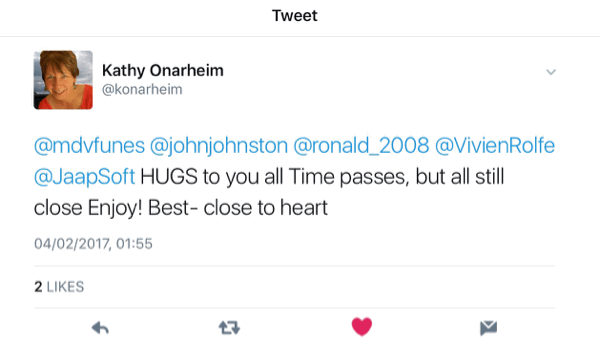
On Wednesday this week I was talking into the mic. Not too unusual given I often broadcast on Radio #EDUtalk on Wednesday evenings.
This week however I was talking to [Ian Guest](@IaninSheffield ) for his research on Twitter for CPD.
Being even less prepared than usual I missed a few things. I was probably more negative about some aspects of twitter than some other folk.
What I did not talk about enough was the positive communities that build up on Twitter. For me #ds106 is a particularly good example, but there are lots more.
This morning when I looked at my notification I see this:
@mdvfunes @johnjohnston @ronald_2008 @VivienRolfe @JaapSoft HUGS to you all Time passes, but all still close Enjoy! Best- close to heart
— Kathy Onarheim (@konarheim) February 4, 2017
After breakfast with the radio news, a lovely contrast. Sometimes tweets are not just passing leaves in the stream and are worth grabbing.
I am enjoying reading The Importance of Working ‘Open’ in Education from @dajbelshaw except for the mullet analogy, some of us lived through the 80s.

A few years ago I posed about an interesting use of Google reverse image search:
And over the years I’ve read a good few posts about the tool on Alan’s blog (e.g. The Hidden Complexity of Attribution, Reverse Image Search ).
This week I’ve been reading more fascinating uses of the tool: Cleanup Time and Road Trip
I am even more strongly minded that we should be starting to teach these skills from a young age. How easy that will be I don’t know.
A few weeks ago, during the scary clown storm I was hearing about clown stories every day. One pupil was most insistent that there was a clown plague. The pupil presented me with ‘evidence’ from his iPad. This was a photo of a dead clown stretched out shot on a New York street. I took a look with the idea of demonstrating a wee bit of fact checking. On scrolling down below the picture I found the headline explaining that this was a fake photo! No detective work needed.
I am not quite sure where to start with this teaching. Perhaps using the reverse image search to identify things or creatures combined with some work on The Pacific Northwest Tree Octopus.
The problem is that the fake stuff is catchy, fun and enables us to grab a quick stance.
Featured image Reversed | Pekka Nikrus | Flickr BY-NC-SA
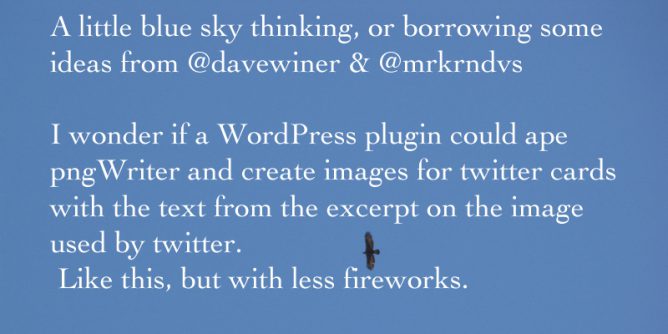
A little blue sky thinking, or borrowing some ideas from @davewiner & @mrkrndvs
I wonder if a WordPress plugin could ape pngWriter and create images for twitter cards with the text from the excerpt on the image used by twitter.
Like this, but with less fireworks.
I’ve been thinking about twitter again.
I think I’d have preferred twitter to be just text rather than being expanded to include all the media and ‘twitter cards’. I’d rather the reading flow would be twitter for short stuff and link to more visual or longer material out on your blog. That would perhaps make reading a little deeper and avoid the problem of folk just seeing the main point of an article and reacting to that 1.
But that cat left the bag a while ago. Now when I look at my twitter stream it is full of images. I occasionally use OneShot to grab and crop out interesting bits of text to share and surmount the 140 char limitation too.
I am not sure if this is a great idea
@everythingabili this buffoon (blush) wonders if blog post with text as a featured image( twitter:image meta ) and in body would be better?
— john johnston (@johnjohnston) November 27, 2016
Recently I’ve watched Dave Winer experimenting with pngWriter (see the about page: About pngWriter). This creates images of blocks of text and sends them out in a tweet. It also creates an RSS feed of the text (pngWriter is not open for use at the moment).
This reminded me of how Aaron uses featured images in his blog: Creative Commons Starts with Making – A Reflection on Creating and Sharing – Read Write Respond
So I am kicking round a couple of ideas.
Here is how I imagine that working
Alternatively (better?) make it the content of the twitter:image metatag for the post, that means that the featured image on the post would not have the text, visitors could read the post.
Or make a copy of the posts featured image, add the text and make that the twitter card image (I can imagine that might be different to get the text readable.).
For a couple of minutes I imagined that my babysteps php & JavaScript could put something like this together. Then reality kicked in. So I though I’d post it out here maybe someone else would think it would be a good idea.

I’ve seen this linked a few times recently, finally clicked.
– […] we may keep, use and share your personal information with companies connected with Instagram. This information includes your name, email address, school, where you live, pictures, phone number, your likes and dislikes, where you go, who your friends are, how often you use Instagram, and any other personal information we find such as your birthday or who you are chatting with, including in private messages (DMs).
I’ll be sharing this with my pupils soon.

Over the years I’ve enjoyed being part of Teach Meet. This new site aims to help promote TeachMeets in Scotland TeachMeet.scot.
From pretty much the start TeachMeets have been organised on the TeachMeet wiki. This can at times get a little messy. There has been various attempts to tidy it up, some breakaway sites. I even worked on an attempt inspired by Ewan to make an alternative international site. That last came to naught.
Very much in my opinion the wiki site does not function well: the front page was huge, with large graphics, spam was getting out of hand too. A couple of years ago I’d spent some time deleting spam comment, and suggested a reduction in logo size on the front page. This didn’t have any impact and I am sure that many folk are quite happy with the wiki.
The new teachmeet.scot site was inspired when talking to Feargual, Susan and Athole last year.
They had set up tmscot.wordpress.com in an attempt to reboot TeachMeet and Scotland and make organising & publicising TeachMeets a little simpler in Scotland. I was interesting in making something a little bit more usable than the pbwiki site.
TeachMeet.scot is the result. It was ‘soft’ launched last year and has been used to organise a few TeachMeets.
It is a work in progress, the aim to be a simple, easy to navigate site. It is open to anyone to use. Currently you can add a TeachMeet in a couple of ways: you can fill in a form and someone will add it for you or you can request an account and add as many as you like. How you organise a meet is up to you, you could use a contact form on the post, an embedded google form, link to eventbright or whatever you like to get folk to sign up1.
It could be used instead of or as well as the TeachMeet Wiki site. We are hoping it will be useful rather than exclusive. There is no axes being ground, no profits being made. I organise the hosting and own the domain, but I consider it held in trust for TeachMeet rather than owned.
If you are organising a TeachMeet in Scotland please have a look and consider using the site. There are plenty of folk who will help you get started if you need a hand. How to use this site – TeachMeet.scot
1. Longer term it is hope to have a booking system built into the sire as another alternative. ↩
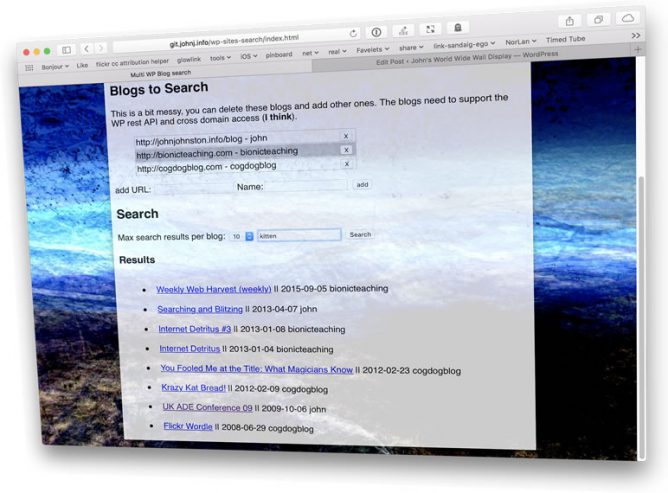
Veering off into territories where I am out of my depth a bit of fun in the last days of the holiday.
I’ve been playing with the new WordPress REST API using ideas from API Nirvana – Functional Details, then I remembered CogDog’s WordPress search javascript bookmarklet.
Multi WP Blog search allows you to search across a few blogs.
I doubt if this is actually a practical way to do things but it hints of ways of joining different blogs, small parts loosely joined?